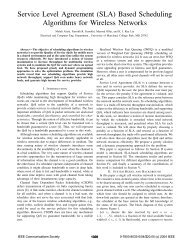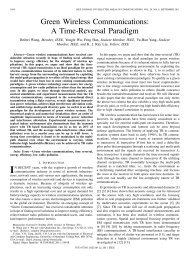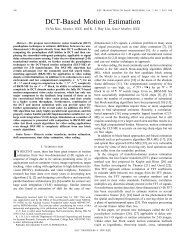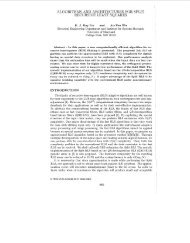A unified square-root-free approach for QRD-based recursive-least ...
A unified square-root-free approach for QRD-based recursive-least ...
A unified square-root-free approach for QRD-based recursive-least ...
Create successful ePaper yourself
Turn your PDF publications into a flip-book with our unique Google optimized e-Paper software.
I<br />
IEEE TRANSACTIONS ON SIGNAL PROCESSING, VOL. 41. NO. 3, MARCH 1993<br />
I409<br />
With (49) substituted into (46), we have<br />
Because & [b,, bZ, . . . , bp, b,,+ ,] = [xi, x2, . . . , x,,, y] is the<br />
appended new data row, we are certainly <strong>free</strong> to choose k, = 1 to<br />
reduce the arithmetic complexity and simplify the expression in<br />
(SO). There<strong>for</strong>e, a lemma on obtaining the sqrt-<strong>free</strong> optimum residual<br />
is given below.<br />
Lemma 1: (Sqrt-<strong>free</strong> Optimum Residual): The optimum residual<br />
e can be computed with no sqrt operations and is given by<br />
if k, is chosen to be unity. 0<br />
McWhirter [ 131 successfully employed Gentleman’s proposition<br />
[5] in computing the residual e without sqrt operations. By choosing<br />
p, = v, = a,, = I, 1 C- i 5 p , the optimum residual can be<br />
reduced to<br />
(Gentleman/McWhirter) (52)<br />
where C, is defined in (2.5). This result is again consistent with the<br />
work by McWhirter [ 131.<br />
Another example can be taken from Hammarling’s suggestion<br />
[9] as follows:<br />
Then it follows that k: = k,a,,/p, and the Hammarling optimum<br />
residual is given by<br />
REFERENCES<br />
[I] E. H. Bareiss, “Numerical solution of the weighted <strong>least</strong> <strong>square</strong>s<br />
problems by G-trans<strong>for</strong>mations,” Tech. Rep. 82-03-NAM-03, Dep.<br />
Elec. Eng. Comput. Sci., Northwestem University, Evanston, IL,<br />
Apr. 1982.<br />
[2] J. L. Barlow and I. C. F. Ipsen, “Scaled Givens rotations <strong>for</strong> the<br />
solution of linear <strong>least</strong> <strong>square</strong>s problems on systolic arrays,” SIAM<br />
J. Sci. Stat. Compur., vol. 8, no. 5, pp. 716-733, Sept. 1987.<br />
[3] G. J. Bier”, Factorizntion Methods <strong>for</strong> Discrefe Sequential Esrimation.<br />
New York: Academic, 1977, p. 44.<br />
[4] M. J. Chen and K. Yao, “Comparisons of QR <strong>least</strong> <strong>square</strong>s algorithms<br />
<strong>for</strong> systolic array processing,” in Proc. Conf. In<strong>for</strong>m. Sci.<br />
Syst., Mar. 1988, pp. 683-688.<br />
[5] W. M. Gentleman, “Least <strong>square</strong>s computations by Givens trans<strong>for</strong>mations<br />
without <strong>square</strong> <strong>root</strong>s,” J. Insf. Math. Appl., vol. 12, pp.<br />
329-336, 1973.<br />
[6] W. M. Gentleman and H. T. Kung, “Matrix triangularization by systolic<br />
arrays,” Proc. SPIE Int. Soc. Opt. Eng., vol. 298, pp. 19-26,<br />
1981.<br />
[7] G. H. Golub and C. F. Van Loan, Matrix Compurations, 2nd ed.<br />
Baltimore, MD: Johns Hopkins Press, 1989.<br />
[SI J. Gotze and U. Schwiegelshohn, “An orthogonal method <strong>for</strong> solving<br />
systems of linear equations without <strong>square</strong> <strong>root</strong>s and with few divisions,”<br />
in Proc. IEEE ICASSP, 1989, pp. 1298-1301.<br />
[9] S. Hammarling, “A note on modifications to the Givens plane rotation,”<br />
J. Inst. Mafh. Appl., vol. 13, pp. 215-218, 1974.<br />
IO] S. Kalson and K. Yao, “Systolic array processing <strong>for</strong> order and time<br />
<strong>recursive</strong> generalized <strong>least</strong> <strong>square</strong>s estimation,” Proc. SPIE Int. Soc.<br />
Opt. Eng., vol. 564, pp. 28-38, 1985.<br />
II] F. Ling, D. Manolakis, and J. G. Proakis, “A <strong>recursive</strong> modified<br />
Gram-Schmidt algorithm <strong>for</strong> <strong>least</strong> <strong>square</strong>s estimation,” IEEE Trans.<br />
Acoust., Speech, Signal Processing, vol. ASSP-34, no. 4, pp. 829-<br />
836, Aug. 1986.<br />
121 F. Ling, “Efficient <strong>least</strong> <strong>square</strong>s lattice algorithm <strong>based</strong> on Givens<br />
rotations with systolic array implementation,” in Proc. IEEE ICASSP,<br />
1989, pp. 1290-1293.<br />
1131 J. G. McWhirter, “Recursive <strong>least</strong> <strong>square</strong>s minimization using a systolic<br />
array,” Proc. SPIEInt. Soc. Opt. Eng., vol. 431, pp. 105-112,<br />
1983.<br />
1141 1. K. Proudler, J. G. McWhirter, and T. J. Shepherd, “The <strong>QRD</strong><strong>based</strong><br />
<strong>least</strong> <strong>square</strong>s lattice algorithm: Some computer simulations using<br />
finite wordlength,” in Proc. IEEE ISCAS, New Orleans, May<br />
1990, pp. 258-261.<br />
[I51 S. F. Hsieh, K. J. R. Liu, and K. Yao, “A <strong>unified</strong> sqrt-<strong>free</strong> rank-I<br />
upidowndating <strong>approach</strong> <strong>for</strong> <strong>recursive</strong> <strong>least</strong> <strong>square</strong>s problems,” in<br />
Proc. IEEE Int. Conf. Acoust., Speech, Signal Processing (ICASSP),<br />
Toronto, May 1991, pp. 1017-1020.<br />
Phase Retrieval Using a Window Function<br />
IV. CONCLUSIONS<br />
The Givens rotation is the most commonly used method in per<strong>for</strong>ming<br />
<strong>QRD</strong> updating. Most of these rotation-<strong>based</strong> methods require<br />
explicit sqrt computations which are undesirable from the<br />
practical VLSI circuit design point of view. Our work is the first<br />
ef<strong>for</strong>t to establish basic understanding of all known sqrt-<strong>free</strong> <strong>QRD</strong><br />
algorithms, from which the basic criterion is seen to be simple. We<br />
have shown that all the current known sqrt-<strong>free</strong> algorithms belong<br />
to the pv family. New sqrt-<strong>free</strong> algorithms can be easily obtained<br />
from this pv family. The issue of choosing optimal parameters /A<br />
and v in terms of computational complexity (hardware and software)<br />
and numerical properties still remains an open question. This<br />
<strong>unified</strong> <strong>approach</strong> also provides a fundamental framework <strong>for</strong> the<br />
sqrt-<strong>free</strong> RLS algorithm, which is essential <strong>for</strong> fast operations and<br />
practical VLSI implementations.<br />
Wooshik Kim and Monson H. Hayes<br />
Abstract-In this correspondence, we consider the problem of reconstructing<br />
a signal from the Fourier intensity of the signal and the Fourier<br />
intensities of two windowed signals: one by a window w (n) and the<br />
other by its complementary window [l - w(n)]. We develop several<br />
conditions under which a signal can be uniquely specified to within<br />
several trivial ambiguities such as sign, translation, and time reversal<br />
from the given conditions. We present a possible reconstruction algorithm<br />
derived from the Gerchberg-Saxton algorithm.<br />
Manuscript received February 5, 1992; revised August 6, 1992. This<br />
work was supported by the Joint Services Program under Contract DAAL-<br />
03 -90-C-OOO4.<br />
The authors are with the School of Electrical Engineering, Georgia Institute<br />
of Technology, Atlanta, GA 30332-0250.<br />
IEEE Log Number 9205997.<br />
1053-587X/93$03.00 0 1993 IEEE






